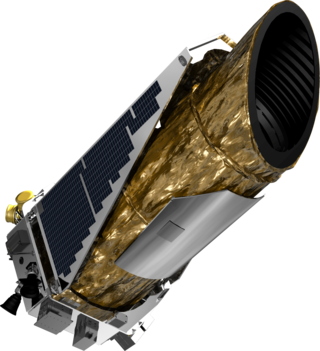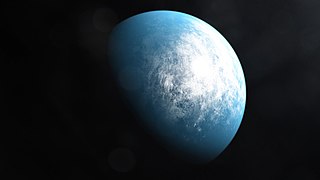
The Kepler space telescope is a defunct space telescope launched by NASA in 2009 to discover Earth-sized planets orbiting other stars. Named after astronomer Johannes Kepler, the spacecraft was launched into an Earth-trailing heliocentric orbit. The principal investigator was William J. Borucki. After nine and a half years of operation, the telescope's reaction control system fuel was depleted, and NASA announced its retirement on October 30, 2018.

A Super-Earth is a type of exoplanet with a mass higher than Earth's, but substantially below those of the Solar System's ice giants, Uranus and Neptune, which are 14.5 and 17 times Earth's, respectively. The term "super-Earth" refers only to the mass of the planet, and so does not imply anything about the surface conditions or habitability. The alternative term "gas dwarfs" may be more accurate for those at the higher end of the mass scale, although "mini-Neptunes" is a more common term.

An exoplanet is a planet located outside the Solar System. The first evidence of an exoplanet was noted as early as 1917, but was not recognized as such until 2016; no planet discovery has yet come from that evidence. What turned out to be the first detection of an exoplanet was published among a list of possible candidates in 1988, though not confirmed until 2003. The first confirmed detection came in 1992, with the discovery of terrestrial-mass planets orbiting the pulsar PSR B1257+12. The first confirmation of an exoplanet orbiting a main-sequence star was made in 1995, when a giant planet was found in a four-day orbit around the nearby star 51 Pegasi. Some exoplanets have been imaged directly by telescopes, but the vast majority have been detected through indirect methods, such as the transit method and the radial-velocity method. As of 1 June 2024, there are 5,742 confirmed exoplanets in 4,237 planetary systems, with 904 systems having more than one planet. This is a list of the most notable discoveries.

K2-33b is a very young super-Neptune exoplanet, orbiting the pre-main-sequence star K2-33. It was discovered by NASA's Kepler spacecraft on its "Second Light" mission. It is located about 456 light-years away from Earth in the constellation of Scorpius. The exoplanet was found by using the transit method, in which the dimming effect that a planet causes as it crosses in front of its star is measured.
K2-72 is a cool red dwarf star of spectral class M2.7V located about 217 light-years away from the Earth in the constellation of Aquarius. It is known to host four planets, all similar in size to Earth, with one of them residing within the habitable zone.
K2-72c is a small exoplanet orbiting around the red dwarf star K2-72 approximately 227.7 light-years away. It is located in the inner edge of the habitable zone. K2-72c completes an orbit in 15.2 days, and it has a radius of only 86% of that of the Earth.
K2-72d is a small exoplanet orbiting around the red dwarf star K2-72 approximately 227.7 light-years away. K2-72d completes an orbit in 7.8 days, and it has a radius of only 73% of that of the Earth.

K2-72e (also known by its EPIC designation EPIC 206209135.04), is a confirmed exoplanet, likely rocky, orbiting within the habitable zone of the red dwarf star K2-72, the outermost of four such planets discovered in the system by NASA's Kepler spacecraft on its "Second Light" mission. It is located about 217.1 light-years (66.56 parsecs, or nearly 2.0538×1015 km) away from Earth in the constellation of Aquarius. The exoplanet was found by using the transit method, in which the dimming effect that a planet causes as it crosses in front of its star is measured.

K2-33 is an extremely young pre-main-sequence star located about 453 light-years (139 pc) away from the Earth in the constellation of Scorpius. It is known to host one planet, a super-Neptune, named K2-33b. It is also notable for its young age.

TRAPPIST-1g, also designated as 2MASS J23062928-0502285 g and K2-112 g, is an exoplanet orbiting around the ultra-cool dwarf star TRAPPIST-1, located 40.7 light-years away from Earth in the constellation Aquarius. It was one of four new exoplanets to be discovered orbiting the star in 2017 using observations from the Spitzer Space Telescope. The exoplanet is within the optimistic habitable zone of its host star. It was found by using the transit method, in which the dimming effect that a planet causes as it crosses in front of its star is measured.
K2-155d is a potentially habitable Super-Earth exoplanet in the K2-155 system. It is the outermost of three known planets orbiting around the K-type star K2-155 in the constellation Taurus. It is one of 15 new exoplanets around red dwarf stars discovered by Japanese astronomer Teruyuki Hirano of the Tokyo Institute of Technology and his team. The team used data from NASA's Kepler Space Telescope during its extended K2 "Second Light" mission. K2-155d orbits near the so-called habitable zone of its system, and has the potential to host liquid water.
K2-229b is an extremely hot, solid, iron-rich exoplanet in a close orbit around the active K-dwarf K2-229 in the constellation Virgo, 335 light years away from Earth.

K2-236b is a Neptune-like exoplanet that orbits an F-type star. It is also called EPIC 211945201 b. Its mass is 27 Earths, it takes 19.5 days to complete one orbit of its star, and is 0.148 AU from its star. Its discovery was announced in 2018. This was the first exoplanet discovered by scientists based in India. The discoverers were Abhijit Chakraborty (PRL), Arpita Roy (Caltech), Rishikesh Sharma (PRL), Suvrath Mahadevan, Priyanka Chaturvedi, Neelam J.S.S.V Prasad (PRL), and B. G. Anandarao (PRL).

K2-288Bb is a super-Earth or mini-Neptune exoplanet orbiting in the habitable zone of K2-288B, a low-mass M-dwarf star in a binary star system in the constellation of Taurus about 226 light-years from Earth. It was discovered by citizen scientists while analysing data from the Kepler spacecraft's K2 mission, and was announced on 7 January 2019. K2-288 is the third transiting planet system identified by the Exoplanet Explorers program, after the six planets of K2-138 and the three planets of K2-233.

TOI-700 d is a near-Earth-sized exoplanet, likely rocky, orbiting within the habitable zone of the red dwarf TOI-700, the outermost planet within the system. It is located roughly 101.4 light-years (31.1 pc) away from Earth in the constellation of Dorado. The exoplanet is the first Earth-sized exoplanet in the habitable zone discovered by the Transiting Exoplanet Survey Satellite (TESS).

LTT 1445 is a triple M-dwarf system 22.4 light-years distant in the constellation Eridanus. The primary LTT 1445 A hosts two exoplanets—one discovered in 2019 that transits the star every 5.36 days, and another found in 2021 that transits the star every 3.12 days, close to a 12:7 resonance. As of October 2022 it is the second closest transiting exoplanet system discovered, with the closest being HD 219134 bc.

Kepler-1649c is an Earth-sized exoplanet, likely rocky, orbiting within the habitable zone of the red dwarf star Kepler-1649, the outermost planet of the planetary system discovered by Kepler’s space telescope. It is located about 301 light-years (92 pc) away from Earth, in the constellation of Cygnus.
K2-315b is an exoplanet located 185.3 light years away from Earth in the southern zodiac constellation Libra. It orbits the red dwarf K2-315.
K2-415 is an M5 red dwarf star located 72 light-years from Earth. K2-415 has a mass that is 16% of the mass of the Sun.












